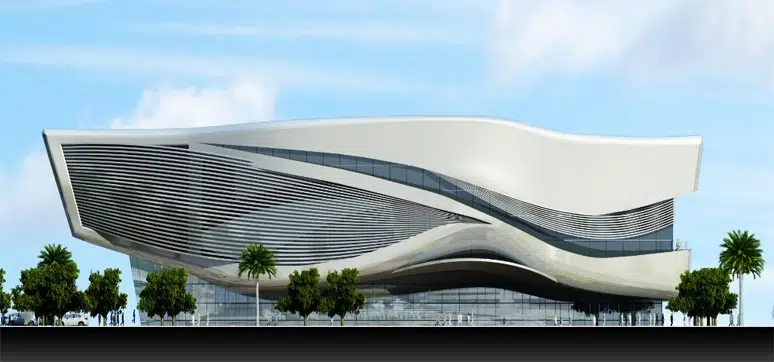How have you seen the adoption of BIM evolve in the field of architecture and façade design over the years?
The adoption of BIM technologies has been experiencing steady and rising demand in the last few years, on the global level and especially in the Gulf Area, where there are a lot of urban development running with huge investments. The evolution of BIM technologies over the last 10 years is notable especially in the area of façade design (building envelope).
The evolution of BIM technologies helped designers to implement their complicated designs, this has resulted in another level of innovation in façade designs and construction. Giving example the works of Architect/ Zaha Hadid, these types of designs wouldn’t be possible to construct without the evolution of BIM technologies, as well as the challenging urban developments like “The Line” Project in the Kingdom of Saudi Arabia.
In your experience, what are the most significant advantages of using BIM in architectural and façade projects?
Using BIM technologies in building envelope and façades design raised the bar for innovation in this area. There are various advantages of BIM technologies implementation in this area, among them, freedom of design, ease of visualisation to clients, ease of construction, ease of fabrication, and addressing coordination issues at the early stage of design. In addition to that, BIM technologies contributed to controlling the cost of the design and controlling the construction timeline. One of BIM’s most significant results is the usage of BIM in sustainable building envelope design, which is the new trend now in façade design.
What are the benefits of implementing BIM and parametric processes for façades?
The evolution of BIM technologies contributed positively to the parametric building envelope design trend development, which is the new trend in building envelope designs.

The implementation of BIM technologies and parametric building envelope design has enriched the façade designs and added a new dimension for innovation in façade design and construction. The implementation of BIM technologies made the construction of the parametric façades possible with a high level of coordination and a low level of site issues. In addition, BIM technologies helped in the visualisation of the parametric building envelope end product, which resulted in clients’ satisfaction.
How do you see BIM integrating with other emerging technologies, such as augmented reality (AR) or virtual reality (VR), in the context of architectural and façade design?
The evolution of Artificial Intelligence (AI) technologies, such as augmented reality (AR) and virtual reality (VR) is the future of the Construction Industry. BIM technologies are well interfacing with Artificial Intelligence (AI) technologies, especially in the area of building envelope design and the design of internal spaces. Through this interface, we can see how the design of the façade will be in reality.
Also, clients can be easily convinced of the architectural design features. Previously, it was difficult for the design and construction team to imagine the façade design from papers or CAD designs, but now the BIM technologies interfacing with Artificial Intelligence (AI) technologies made that much easier and more realistic.
What challenges do you believe still exist in the widespread adoption of BIM in the architecture and façade industry?
Several challenges prevent the widespread adoption of BIM technologies in the building industry, still, the BIM technology cost is high in terms of program licenses and computer hardware, which is a major challenge. Some clients are looking into the high cost of BIM technology implementation and requesting to use regular CAD technology t decrease the cost.
I can see this issue resolved if the Governments mandate to enforce the use of BIM technologies by law. There is a success story in enforcing the use of BIM technologies by the Government of Emirates, Qatar, and recently Kingdom of Saudi Arabia. In addition to the learning and education challenges, where most of the universities now are teaching curriculum related to BIM technologies for Architectural and Engineering fields of study.
How can BIM contribute to sustainable design practices, particularly in the context of façade materials and energy efficiency?
Sustainability depends somehow on technological advances, especially in the part that concentrates on energy efficiency and the usage of sustainable building materials. “Green BIM” technologies concentrate on modeling the building environmental information, aiming to achieve the balance between building construction and energy efficiency through the building life cycle.
The “Green BIM” technologies contribute positively to studying the building energy efficiency model including the energy efficiency of the building envelope. Moreover, the “Green BIM” technologies contribute to monitoring the building energy efficiency in the stage of facility management and through the facility maintenance protocols.
Are there any emerging trends or technologies in BIM that you believe will significantly impact the future of architecture and façade design?
The future trend in the construction industry is for the interface and collaboration between BIM technologies and Artificial Intelligence (AI) technologies, in addition to the linkage with sustainability of the external building envelope and façade and internal buildings’ operations.
How technology can be used to reduce costs, reduce defects, and improve designs?
Reduction and efficiency of the cost of the projects is the main concern for clients and end users. Advanced building technologies including BIM technologies, Artificial Intelligence (AI) technologies, and sustainability practices aim to produce the best design at the optimum cost. BIM technologies help in material cost reduction and energy cost reduction.
The life cycle cost is the main parameter, not the initial cost which might be higher due to the cost of the technology, but in the long run, there will be cost reduction in building operation and maintenance. An example of this is the initial cost of heat efficiency of the building, it seems high, but the electricity bills over the long run (life cycle) of the building will show much reduction.
What are the requirements and differences in BIM and parametric procedures?
The BIM processes are the processes related to the modeling of the building information in Architectural, Structural, Mechanical, and Electrical areas, using software like Revit or ArchiCAD programs, while the parametric modeling is the computational design of different building objects (mainly in the building envelope) using different sets of software like SketchUp, Grasshopper, and Dynamo. Both BIM and parametric design collaborate in the final modeling process to produce a certain building.
The simple parametric procedure is more of a design innovation process and tool, while BIM requirements are more in the direction of modelling the building components, whether it has resulted from a parametric process or not.
How 3D parametric modelling and automation can help meet customer demands?
Usually, the customer approaches the architecture/engineering firms to translate his needs into reality, with the most optimised and cost-effective project value. The 3D parametric modelling and automation results in real building models which can give a full picture to the client about how his building will look, mainly in the building envelope and internal spaces design.
This was not possible before; the clients couldn’t get a full picture of their buildings before the construction stage finished and the building was handed over for operation. Now clients can change their buildings easily several times before printing the construction documents by using 3D parametric design modelling and BIM technologies. Simply it can bring clients’ dreams into touchable reality.
Why does BIM appear to be fundamental in the current architectural design? How can architects use BIM to streamline complex façade design?
BIM technologies are now essential in design, not only for complex building designs or complex façade designs, but for all types of buildings. The BIM technologies cut a lot of time in visualisation and coordination and ensure that the end product is free of clashes and construction issues. BIM technologies ensure cost-effective design and suitability to the surrounding environmental conditions.
BIM technologies help Architects and Engineers work the façade design with the parametric process to model and construct their designs. BIM technologies interface with Artificial Intelligence (AI) technologies creating an easy cyber environment where the clients can easily imagine every aspect of their future building. BIM technologies support architects in understanding, designing, and constructing their complex façades.















